-
Car Reviews
- All reviews
- Midsize SUVs
- Small cars
- Utes
- Small SUVs
- Large SUVs
- Large cars
- Sports SUVs
- Sports cars
- Vans
Latest reviews
- Car News
-
Car Comparisons
Latest comparisons
- Chasing Deals
All the high voltage parts of a Polestar 2 in a trendier SUV skin, the 300kW XC40 may not be efficient, but it’s cool, practical and has an excellent sound system
Volvo began its electric transformation under Geely ownership with the XC40 Recharge Twin Pure Electric we have on test. This was the first ever all-electric Volvo. It debuted globally in July 2021 but took some time to hit Australia with deliveries of this twin motor XC40 ($76,990 before on-road costs) commencing in December 2021.
The XC40 may have been the first, but is now one of three electric vehicles based on Volvo/Polestar’s Compact Modular Architecture (CMA) underpinnings – the other two are currently the Polestar 2 sedan and soon-to-launch Volvo C40 coupe SUV.
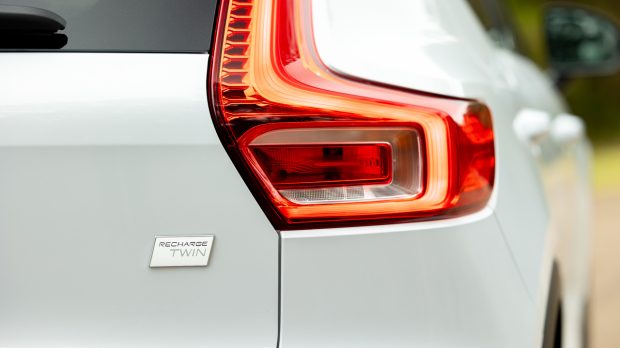
These underpinnings were designed from the outset with electrification and ICE vehicles in mind and mark the beginning of Volvo’s pledge to become a fully electric car manufacturer by 2030.
A facelifted MY23 XC40 wearing a $3000 higher price tag ($79,990) is on its way to Australia, though the refreshed twin motor claims an identical 418km of WLTP range from a charge of its 75kWh (usable) lithium-ion battery.
The suspension and guts of the car remain very similar for MY23 with only really infotainment updates and a light front-end reskin coming.
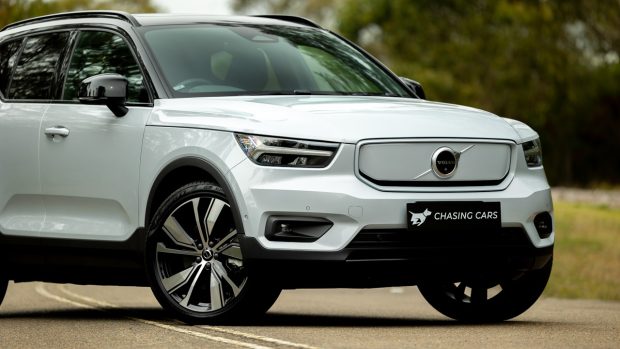
The sales story so far is that Volvo – not unlike Tesla with its Model 3 and Y, Hyundai with Ioniq 5, Kia with EV6 – has had difficulties securing supply of the XC40 Recharge due to European demand and chip shortages.
MY22 models are all sold out, though a shipment of MY23 facelift examples – including a more affordable single-motor variant ($72,990) – will arrive in September/October this year. Unfortunately, sources confirmed to Chasing Cars that the allocation of MY23 twin motors is essentially all spoken for, though there are a handful of single motors available in the coming shipment.
We can see why people were interested in the XC40. This Volvo’s upright and boxy SUV design has struck a chord in the Chasing Cars office. Even though we love the futuristic Polestar 2 and forthcoming C40, the XC40’s blend of traditional Swedish brickiness with sparse contemporary detailing makes it one of the most handsome EVs on sale.
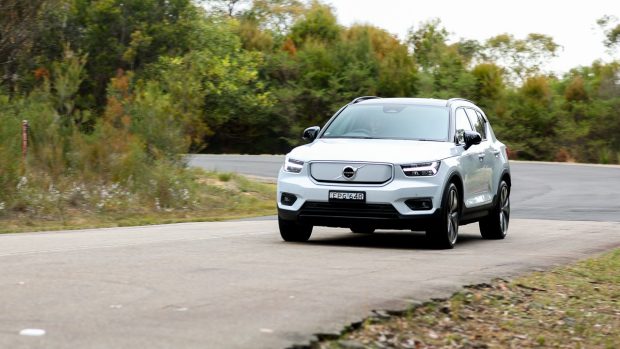
Of course, the focus on upright angles isn’t all good, especially for aerodynamics. The XC40 electric is not the most efficient BEV. With claimed WLTP consumption of 18kWh/100km, it’s more than 30 percent thirstier than a Tesla Model Y (13.8kWh/100km).
This relative inefficiency leads to reduced range and higher running costs: 418km is the XC40’s WLTP number, but in reality we got more like 350-375km from a charge. Still, you may be more than comfortable with this given the XC40’s style and likability.
Quick pace off the line defines how the XC40 electric drives. With twin motors producing 300kW of power and 660Nm of torque, the 2158kg XC40 is capable of hitting 100km/h in 4.9 seconds, though we managed an even faster 4.64 second time in independent Chasing Cars testing. That’s proper quick for a small SUV, and makes this unassuming volvo nearly rapid enough to trouble an Audi RSQ3 (4.5 seconds).
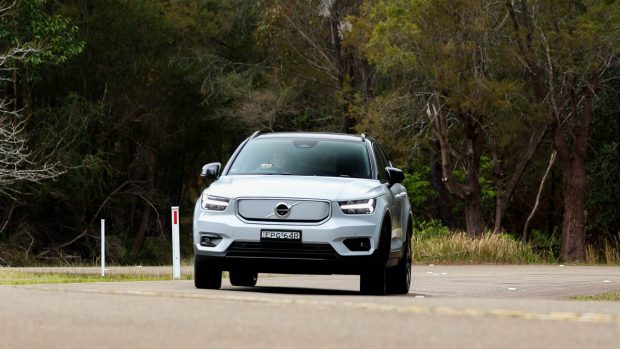
The twin-motor Volvo XC40 electric is as quick as a performance SUV from a dig, though its height and weight mean this is not an athletic SUV in corners. The steering is light and digital with almost no feel. Road holding and outright grip is certainly adequate and predictable, but the XC40 is not a driver’s EV.
I’d argue that you don’t need a family vehicle to be quite as fast as this XC40 is. The twin motor is fun, but I’d argue the single motor vehicle that uses one of this car’s 170kW/330Nm on the front axle is plenty. It also saves a bit of cash – $4000 less than the MY23 Twin Motor tested, and $7000 over the MY23 Twin Motor ($79,990 before on-road costs).
Settling for the single motor won’t impact the XC40’s beguiling silent operation either. The only noise in the cabin is some rear suspension resonance. We’ve noted this low-pitch sound in Polestar 2, but the XC40’s wagon body seems to amplify it further.
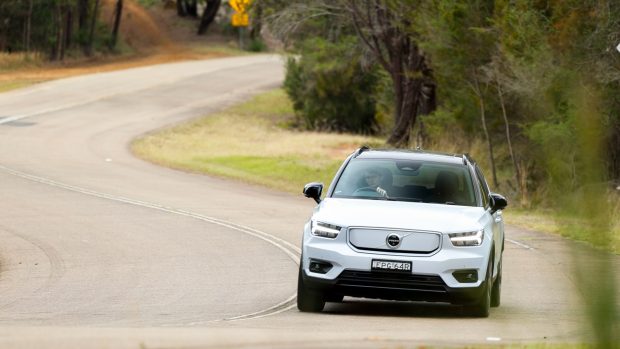
With its 235/40 R20 Pirelli P Zero tyres set to their 41 psi recommended pressures the XC40’s ride can be fidgety and unsettled around town. Presumably, those high pressures improve range. Dropping all four corners to 38 psi dramatically improved the XC40’s jostling secondary ride – probably at the expense of 10km range, but around town it’s so worth it.
Out on the open road the ride settles quite dramatically. There’s still a firm edge necessary for the XC40 electric to control its body – the 20-inch alloys add to this – but it is not uncompromising on country back roads. The evenly-split AWD system also brings security in inclement conditions.
One feature that sets the XC40 electric apart from its fossil-fuel burning siblings is the way you start it. Instead of turning a key, thumbing a start button, or twisting a glass knob, the electric XC40 simply requires the driver to plug in the seat belt and pull the stitched leather gear stick back to ‘D’. The reverse is true for shutting down: stop, press ‘P’ and exit. Easy as that.
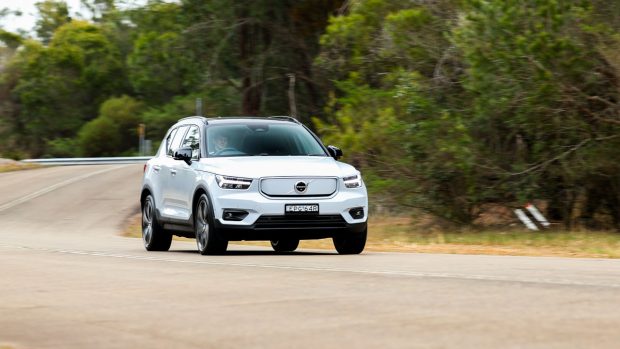
You’re reminded this is an EV again by its one-pedal driving mode. There are two settings – light and full. Some in the office prefer the more natural, less aggressive mode, but for me one-pedal driving is half the appeal of an electric vehicle, and Volvo/Polestar’s system seems to be right up there with Tesla. The XC40’s brake pedal feel is pretty natural as well.
Safety features are typically strong. The standard 360-degree camera is very high resolution, and the XC40 includes the usual front AEB with pedestrian and cyclist detection, reverse AEB, front and rear parking sensors, blind-spot monitoring, driver attention monitoring, lane-trace assist and adaptive cruise control. The XC40 received a five-star ANCAP rating in 2018.
One thing’s certain: Volvo’s XC40 is not another BMW/Mercedes-Benz/Audi clone inside. There is a distinct Scandinavian flavour in here that (aside from the absence of beech or pine wood) feels a lot like the sort of living room a Swede would assemble, including the excellent 13-speaker 660W Harman/Kardon sound system.
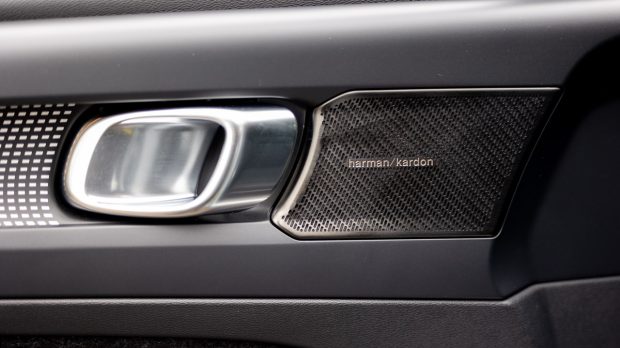
The sound system seems an oft-forgotten point today, with all cars offering much better systems than what was the norm just a decade ago, but Volvo always goes above and beyond. The XC40’s system is enveloping, powerful, clear and sounds delightfully natural. The little things really go a long way.
Furthering the XC40’s upright design scheme is the 9.0-inch portrait oriented touchscreen set into a piano black bezel between to attractive vents. The screen is responsive and is powered by an attractive Google Android Automotive operating system that allows users to download applications such as Spotify via the car’s onboard internet connection.
The Android operating system means the XC40 runs Google Maps as its native navigation. This is excellent, and offers live-traffic updates as well as the ability to search destinations as you would in your smartphone, rather than (hard work) entering a street address. Phone-driven Apple CarPlay and Android Auto feature as well, though they require a wired USB-C connection found above the wireless charging pad.
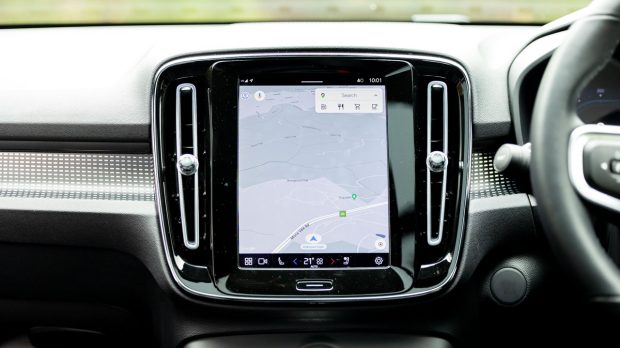
All of the XC40’s cabin plastics feel high quality, with a soft-mould dashboard, door tops and quality graining on the harder plastics below the belt line. XC40’s driving position is set quite upright with extremely supportive, electrically-adjustable heated seats appointed in leather.
Volvo has appointed the inside of the XC40’s door cards in a thick marine-carpet-chic material. It’s one step further than Volkswagen’s flock-lined door cards and helps to stop anything stored in there from rattling around. The pockets themselves are easily big enough for two 1.0-litre camping bottles. A pair of well-sized cup holders reside in the centre console.
In the back seat the Volvo is a small SUV more in line with the space of a BMW X1 and Audi Q3 than more mainstream Mazda CX-30s and VW T-Rocs. That means the XC40 is a usable vehicle for a small family, if tighter in here than the vast Hyundai Ioniq 5.
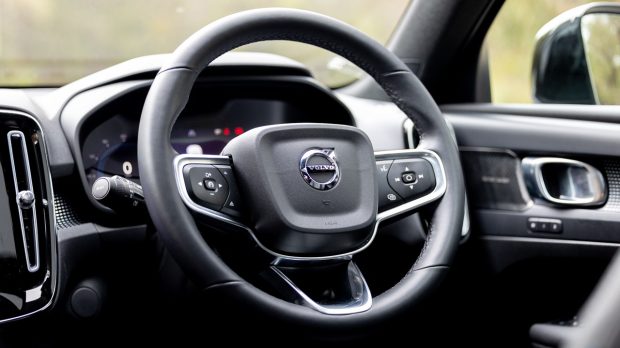
At 188cm tall, I was comfortable in the Volvo’s back seat. Unfortunately the floor isn’t flat as the batteries are arranged in a central ‘spine’ in the transmission tunnel, so the back quarters are best capped at four.
The Chasing Cars rear-facing infant and front-facing child seats proved easy to fit. Isofix ports are easy to locate as are top tether points. Extra point to the Volvo’s smart headrests that are designed to have top tether straps slide seamlessly through the middle for no fiddly removal or lost headrests.
The electric Volvo XC40 is a little less practical than ICE cars, the rear cargo area is 418L rather than 460L. That said, the 39L front boot under the attractive clamshell bonnet brings total space much closer. It’s also the perfect spot to stow your Type 2 charging cable.
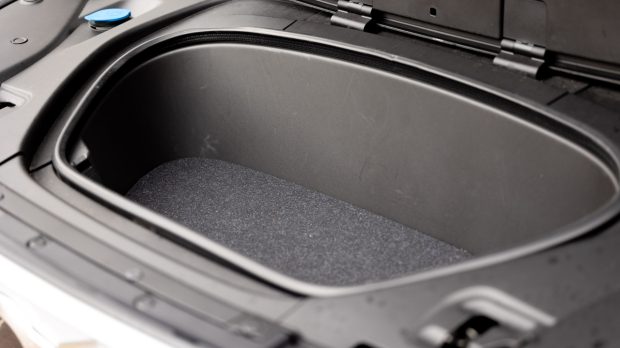
With fuel prices all over the place and set to rise further, an electric vehicle is an excellent choice to cut your bottom line. Public fast-charging rates may be dearer than before at $0.60/kWh, but charging at home is what most owners will do.
The Volvo XC40 is capable of DC fast-charging at a rate of 150kW. This recuperates from 10-80 percent charge – or 42km-335km range – in 40 minutes, according to Volvo.
Charging the XC40’s 75kWh (usable) lithium-ion from 0-100 percent using a three-phase 11kW wallbox will take around eight hours, and a more typical single-phase 7kW charging box around 11 hours.
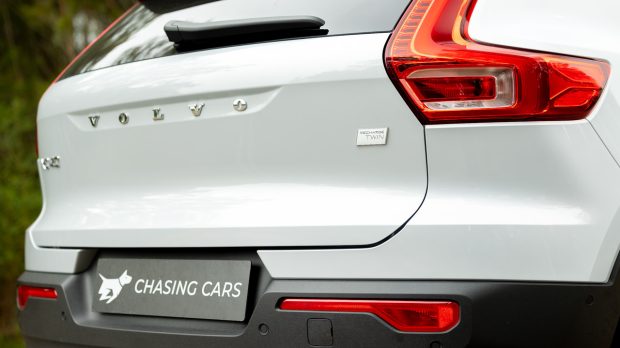
Where the XC40 struggles is consumption. It is quite an energy-hungry EV, especially travelling at higher speeds. In urban loops we saw 18kWh/100km, enough to match Volvo’s WLTP range claim of 418km.
However, in another combination of urban and open roads with the air-con set to 22-degrees the twin-motor XC40’s consumption spiked to 21kWh/100km meaning a real-world range of about 360km. In previous experience – including in our long-term Polestar 2 – we’ve seen this fall further on long motorway stints.
Compared to a Tesla Model Y, which averaged 16.8kWh in a recent roadtrip test (you can watch that here), the XC40 is a pretty thirsty beast.
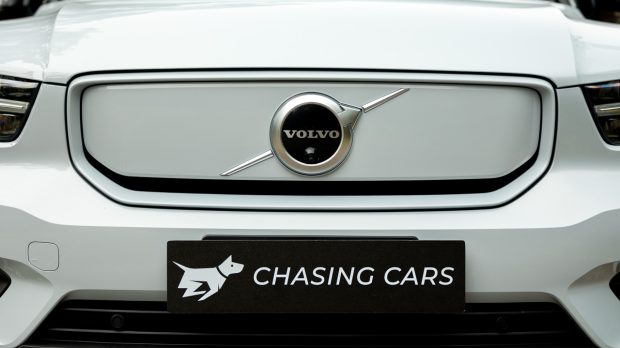
But it may be a largely moot point if you have substantial rooftop solar. Even if you charge at rates of around $0.25/kWh, the difference over 15,000km of driving in a given year is only around $125 per year in favour of the Tesla in home electricity costs.
There’s the option of a single-motor 170kW/330Nm XC40 electric from MY23 onwards that consumes 15.8kWh/100km in WLTP testing, which seems great. Except, the single motor can only be teamed with a smaller 67kWh battery. It’s a shame the single motor can’t be combined with the big battery pack as offered by Polestar.
Servicing is easy to understand for the XC40 electric. It’s carried out on a condition-based model with Volvo including three years/100,00km of maintenance in the XC40’s price.
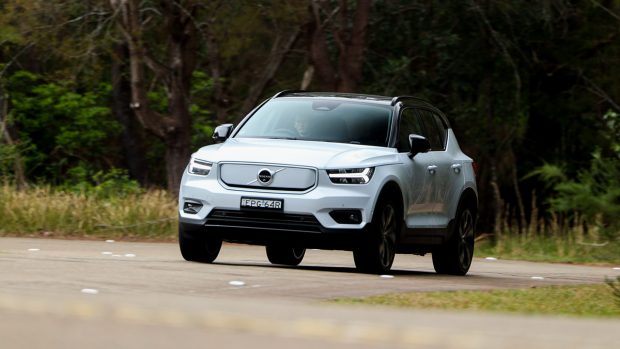
Volvo also covers the XC40 with a five-year/unlimited kilometre warranty. The 75kWh lithium-ion battery is guaranteed by its manufacturer for eight-years/unlimited kilometres.
The Volvo XC40 Recharge Twin Pure Electric is a great partner for buyers seeking a well-built, swift electric car – but if you’re after a true long-range vehicle, the Volvo’s prohibitively high consumption makes it compromised for such a task.
If you’re retaining a petrol second car with the purchase of a new EV, the XC40’s surprising turn of speed, safe handling and cool design will surely be of interest.
The interior, refinement and excellent sound system mean it’s quite easy to fall in love with the XC40 around town. And, even though on the surface the Polestar 2 has a lower price-of-entry, once loaded up with leather, safety features and twin motors, it’s dearer.
That leaves the XC40 as an EV for those that are fans of cool, interesting vehicles. This is not electrification for the masses but the XC40 gives plenty of reasons for an owner to fall in love.
Variant tested XC40 Recharge Pure Electric
Key specs (as tested)
About Chasing cars
Chasing Cars reviews are 100% independent.
Because we are powered by Budget Direct Insurance, we don’t receive advertising or sales revenue from car manufacturers.
We’re truly independent – giving you Australia’s best car reviews.
The estimate provided does not take into account your personal circumstances but is intended to give a general indication of the cost of insurance, in order to obtain a complete quote, please visit www.budgetdirect.com.au. Estimate includes 15%^ online discount.
^Conditions Apply
Budget Direct Insurance arranged by Auto & General Services Pty Ltd ACN 003 617 909(AGS) AFSL 241 411, for and on behalf of the insurer, Auto & General Insurance Company Limited(ABN 42 111 586 353, AFSL 285 571).Because we don’t know your financial needs, we can’t advise you if this insurance will suit you. You should consider your needs and the Product Disclosure Statement before making a decision to buy insurance. Terms and conditions apply.
Indicative quote based on assumptions including postcode , 40 year old male with no offences, licence suspensions or claims in the last 5 years, a NCD Rating 1 and no younger drivers listed. White car, driven up to 10,000kms a year, unfinanced, with no modifications, factory options and/or non-standard accessories, private use only and garaged at night.
^Online Discounts Terms & Conditions
1. Discounts apply to the premium paid for a new Budget Direct Gold Comprehensive Car Insurance, Third Party Property Only or Third Party Property, Fire & Theft Insurance policy initiated online on or after 29 March 2017. Discounts do not apply to optional Roadside Assistance.
2. Discounts do not apply to any renewal offer of insurance.
3. Discounts only apply to the insurance portion of the premium. Discounts are applied before government charges, taxes, levies and fees, including instalment processing fees (as applicable). The full extent of discounts may therefore be impacted.
4. We reserve the right to change the offer without notice.